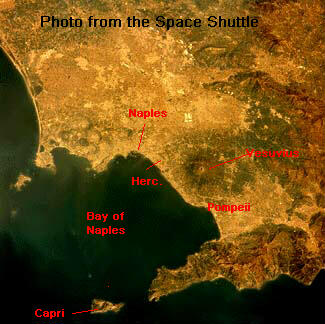
 Naples
Naples

NAPOLI (Naples) - is the largest city of Italy's Campania region, 185 km. southwest of Rome.
It is the capital of the province and the third most populated city in Italy after Rome and Milan.
It is situated between Vesuvius and the Phlegrean Fields and is stretched around the Bay of Naples, beyond a series of islands, like Capri, and peninsulas is the Tyrrhenean Sea.. It has a mild and constant climate. It is one of the most important industrial centers (metalworking, oil refineries, mechanics, electricity and food producing) and trading ports of Italy (the largest Italian port) and has a large international airport..
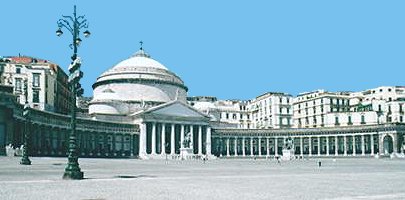 History of Naples
History of Naples
Founded in the 5th century B.C. by the Greeks of Cumae following the naval battle,Although conquered by the Romans in 327 B.C., the city maintained good relations with Athens.
In 1140 Naples was integrated into the Kingdom of Sicily under the Normans. In 1189 it became part of the Hohenstaufen Kingdom. Frederick II, Holy Roman Emperor and King of Sicily, founded a university there in 1224.
At the Pope's incentive, Charles I of Anjou, who was the King of Sicily from 1265 until 1285, put an end to the Hohenstaufen domination of Naples and relocated the capital from Palermo to Naples. Under the authority of Anjou, Naples enjoyed two centuries of prosperity. The Castel Nuovo was constructed in 1279 and several Gothic churches were erected.
The succession of the Aragon Dynasty in 1442 and especially that of King Ferdinand I were followed by a period of architectural and urban achievements.
After being ruled by the French, then becoming a province of the Spanish Empire in the 16th and 17th centuries, Naples became part of the Kingdom of Italy in 1860.
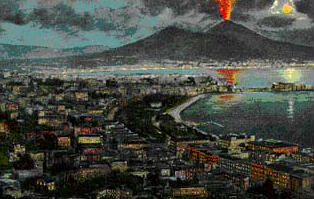 Throughout the long history of Naples, the fortifications were enlarged, reinforced and updated; in places, the original wall is still visible.
Throughout the long history of Naples, the fortifications were enlarged, reinforced and updated; in places, the original wall is still visible.
From the time of ancient Neapolis, some of the east-west roads have survived, and today these form, with the transversal roads, a series of blocks running perpendicular to the slope. Elsewhere in the city, an irregular network layout testify to the medieval and Spanish eras in its history. Other urban features of Naples, such as the Piazza del Mercato, which dates to the 19th century, reflect its more recent period.
This exceptional urban framework also includes major monuments and sites, including the Castel Nuovo and its triumphal arch near the port, the "Charteuse" of Saint Martin on the Vomero Hill and the Villa Floridiana at the edge of the city. The city's religious and secular architecture illustrates a succession of styles, including Romanesque, provincial Gothic, Catalan, Tuscan, Renaissance, Baroque, Classical and Neoclassical. Sprinkled with religious buildings adorned with rich interiors, the urban fabric is extremely dense.
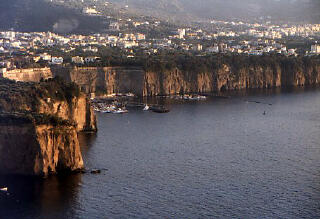 Sorrento
Sorrento
Sorrento is one of the world's beloved seaside resorts. Situated on a Campanian Region peninsula south of Naples, its main industry is tourism. For the past two centuries, visitors from all over Europe and the world have come to enjoy Sorrento's cliffside terraces and rocky, bay beaches.
Despite Sorrento's popularity with travelers, laws of supply and demand seem suspended here, as inexpensive accommodations and food are easily found. The local Museo Correale di Terranova features a fine collection of Greek, Byzantine, and Roman art. And after long days in the Mediterranean sun, Sorrento's central Piazza Tasso attracts scores of evening strollers.
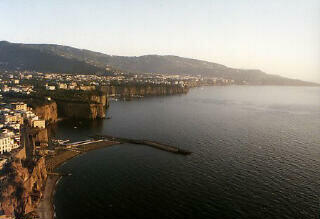 Sorrento makes a fine base for exploring offshore islands, as well as the rugged Amalfi coast on the southern edge of the Sorrentine Peninsula.
Sorrento makes a fine base for exploring offshore islands, as well as the rugged Amalfi coast on the southern edge of the Sorrentine Peninsula.
If not accommodating tourists, many Sorrento residents are occupied with craftwork and food processing. The city is known for its inlaid woodworks, as well as cheeses, olive oil, and limoncello liqueur.
 Return to the Fridge door
Return to the Fridge door